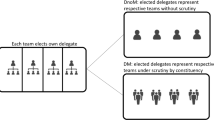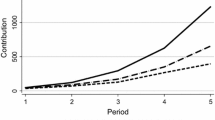Abstract
We experimentally investigate whether groups of heterogeneous agents can reach an agreement on how to share the costs of providing a public good. Thereby, we explore the performance of different burden sharing rules being implemented either endogenously or exogenously. In case of an endogenously implemented burden sharing rule, subjects vote for different burden sharing schemes either by unanimity or majority vote. Despite the fact that preferences for the allocation schemes differ among agents, most groups agree upon a common scheme, and consequently avoid an uncoordinated action. Our results reveal both the opportunities and risks of burden sharing negotiations. We find average efficiency levels to increase in case an agreement is reached. If groups however fail to agree upon a common rule, cooperation collapses and efficiency levels decrease compared to a voluntary contribution mechanism being exogenously imposed. Most importantly, agents who face a voting decision on average receive higher payoffs than agents in an exogenously implemented voluntary contribution mechanism and do not earn less than participants in any externally determined burden sharing rule.




Similar content being viewed by others
Notes
In our experiment, integer multiples of three are required for \(Q_{i}^{min}\).
Mathematically, the weakly dominant strategy of type40 players is to choose \(Q_i^{min}=80\), but the minimum group provision level has to be an integer multiple of three. Therefore, the weakly dominant strategy is to choose the greatest integer multiple of three below 80.
See Supplementary Material Section 1 for a graphical illustration and the analytical solution.
The payoff function of type40 players is not monotonically increasing in \(Q^{min}\). Therefore, depending on their beliefs about the other players’ proposals, the best response of type40 players is to propose \(Q_{type40}^{min}=0\) or \(Q_{type40}^{min}=E\). We assume type40 players to anticipate the weakly dominant strategies of their group members and since their payoff is maximized by \(Q_{type40}^{min}=E\) then, we expect type40 players to propose full contributions.
In a situation where type20 and type30 players suggest eqpay under unanimity voting, the VCM might emerge as an equilibrium if type40 players do not expect the two other types to follow their weakly dominant strategies. Consequently, the best response of type40 players is to propose \(Q_{type40}^{min}=0\), which corresponds to the VCM.
See Supplementary Material Section 2 for a detailed description and a graphical illustration.
We provide the instructions and screenshots in Sections 4 and 5 of the Supplementary Material.
See Supplementary Material in Section 2 for a graphical illustration. We are aware that inequality might also be indirectly reduced by voluntarily exceeding the required individual minimum level. For instance, type40 players might have an incentive to contribute more than required in order to reduce inequality. Anticipating this, type20 and type30 players might have an incentive to reduce the binding minimum contribution order to free ride on the voluntary contributions of the type40 player. However, we focus on the case where players try to directly reduce inequality by implementing a binding minimum contribution level.
See Supplementary Material Section 3 for a detailed graphical illustration of the voting behavior in the respective rounds of the collective-choice phase of the Multi-Phase Game, either under majority or under unanimity rule voting.
A series of random-effects regression models is used in order to determine the payoffs of individuals. The discussion of the results is based on standard errors computed at group level. We consider individual level random effects, i.e., one observation of one individual corresponds to the panel variable and the period defines the time variable. All in all, our econometric analysis comprises 3630 observations. Due to missing sociodemographic information, we had to remove three out of the 366 participants from our economic analysis. Regarding the remaining 363 subjects, we have one observation for each of the 10 payoff-relevant periods.
References
Anderson LR, Mellor JM, Milyo J (2008) Inequality and public good provision: an experimental analysis. J Socio Econ 37:1010–1028
Balafoutas L, Kocher M, Putterman L, Sutter M (2013) Equality, equity and incentives: an experiment. Eur Econ Rev 60:32–51
Blanco M, Engelmann D, Normann H (2011) A within-subject analysis of other-regarding preferences. Games Econ Behav 72:321–338
Chan K, Mestelman S, Moir R, Muller RA (1996) The voluntary provision of public goods under varying income distributions. Can J Econ 70:263–289
Chan K, Mestelman S, Moir R, Muller RA (1999) Heterogeneity and the voluntary provision of public goods. Exp Econ 2:5–30
Cherry TL, Croll S, Shogren JF (2005) The impact of endowment heterogeneity and origin on public good contributions: evidence from the lab. J Econ Behav Org 57:357–365
Dal Bó P, Foster A, Putterman L (2010) Experimental evidence on the effect of democracy. Am Econ Rev 100:2205–2229
Dannenberg A, Lange A, Sturm B (2014) Participation and commitment in voluntary coalitions to provide public goods. Economica 81:257–275
Ertan A, Page T, Putterman L (2009) Who to punish? Individual decisions and majority rule in mitigating the free rider problem. Eur Econ Rev 53:495–511
Fehr E, Schmidt K (1999) A theory of fairness, competition and cooperation. Q J Econ 114:817–868
Fischbacher U (2007) Z-Tree: Zurich toolbox for ready-made economic experiments. Exp Econ 10:171–178
Fisher J, Isaac R, Schatzberg J, Walker J (1995) Heterogeneous demand for public goods: behavior in the voluntary contributions mechanism. Public Choice 85:249–266
Frey B, Benz M, Stutzer A (2004) Introducing procedural utility: not only what, but also how matters. J Inst Theor Econ 160:377–401
Georgantzis N, Proestakis A (2011) Accounting for Real Wealth in Heterogeneous Public Good Games. University of Granada, Discussion Papers No. 10/20
Greiner B (2015) Subject pool recruitment procedures: organizing experiments with ORSEE. J Econ Sci Assoc 1:114–125
Hoffman E, Plott C (1993) Pre-meeting discussions and the possibility of coalition-breaking procedures in majority rule committees. Public Choice 40:21–39
Isaac RM, Norton DA (2013) Endogenous institutions and the possibility of reverse crowding out. Public Choice 156:253–284
Johansson-Stenman O, Konow J (2010) Fair air: distributive justice and environmental economics. Environ Resour Econ 46:147–166
Kesternich M, Lange A, Sturm B (2014a) The impact of burden sharing rules on the voluntary provision of public goods. J Econ Behav Org 105:107–123
Kesternich M, Lange A, Sturm B (2014b) On the performance of rule-based contribution schemes under endowment heterogeneity. ZEW Discussion Paper No. 14-055
Kesternich M, Löschel A, Ziegler A (2014c) Negotiating weights for burden sharing rules among heterogeneous parties: empirical evidence from a survey among delegates in international climate negotiations. ZEW Discussion Paper No. 14-031
Kittel B, Paetzel F, Traub S (2011) Equity and equality in voting on redistribution: a real-effort experiment. Working Paper, University of Bremen, Germany
Kosfeld M, Okada A, Riedl A (2009) Institution formation in public goods games. Am Econ Rev 99:1335–1355
Lange A, Löschel A, Vogt C, Ziegler A (2010) On the self-interested use of equity in international climate negotiations. Eur Econ Rev 54:359–375
Lange A, Vogt C, Ziegler A (2007) On the importance of equity in international climate policy: an empirical analysis. Energy Econ 29:545–562
Ledyard J (1995) Public goods: a survey of experimental research. In: Kagel J, Roth A (eds) The handbook of experimental economics. Princeton University Press, Princeton, pp 111–194
Margreiter M, Sutter M, Dittrich D (2005) Individual and collective choice and voting in common pool resource problem with heterogeneous actors. Environ Resour Econ 32:241–271
Orzen H (2008) Fundraising through competition: evidence from the lab. CeDEx Discussion Paper, No. 2008-11, University of Nottingham
Ostrom E (1990) Governing the commons: the evolution of institutions for collective action. Cambridge University Press, New York
Plott C, Levine M (1978) A model of Agenda influence on committee decisions. Am Econ Rev 68:146–160
Pommerehne W, Weck-Hannemann H (1996) Tax rates, tax administration and income tax evasion in Switzerland. Public Choice 88:161–170
Rawls J (1971) A theory of justice. Harvard University Press, Cambridge
Reuben E, Riedl A (2013) Enforcement of contribution norms in public goods games with heterogeneous populations. Games Econ Behav 77:122–137
Schwarte C (2011) The limitations of consensus. FIELD Foundation for International Environmental Law and Development, June 2011
Sutter M, Haigner S, Kocher M (2010) Choosing the carrot or the stick? Endogenous institutional choice in social dilemma situations. Rev Econ Stud 77:1540–1566
Tan F (2008) Punishment in a linear public good game with productivity heterogeneity. De Economist 156:269–293
Tyran J, Feld L (2006) Achieving compliance when legal sanctions are non-deterrent. Scand J Econ 108:135–156
van Dijk F, Sonnemans J, van Winden F (2002) Social ties in a public good experiment. J Public Econ 85:275–299
Vogel J (2014) The problem with consensus in the UN framework convention on climate change. Philos Public Policy Q 32:14–21
Zelmer J (2003) Linear public good experiments: a meta-analysis. Exp Econ 6:299–310
Author information
Authors and Affiliations
Corresponding author
Electronic supplementary material
Below is the link to the electronic supplementary material.
Rights and permissions
About this article
Cite this article
Gallier, C., Kesternich, M. & Sturm, B. Voting for Burden Sharing Rules in Public Goods Games. Environ Resource Econ 67, 535–557 (2017). https://doi.org/10.1007/s10640-016-0022-6
Accepted:
Published:
Issue Date:
DOI: https://doi.org/10.1007/s10640-016-0022-6
Keywords
- Public goods
- Experiment
- Cooperation
- Burden sharing
- Minimum contribution rules
- Voting
- Endogenous institutions
- Agreement formation




